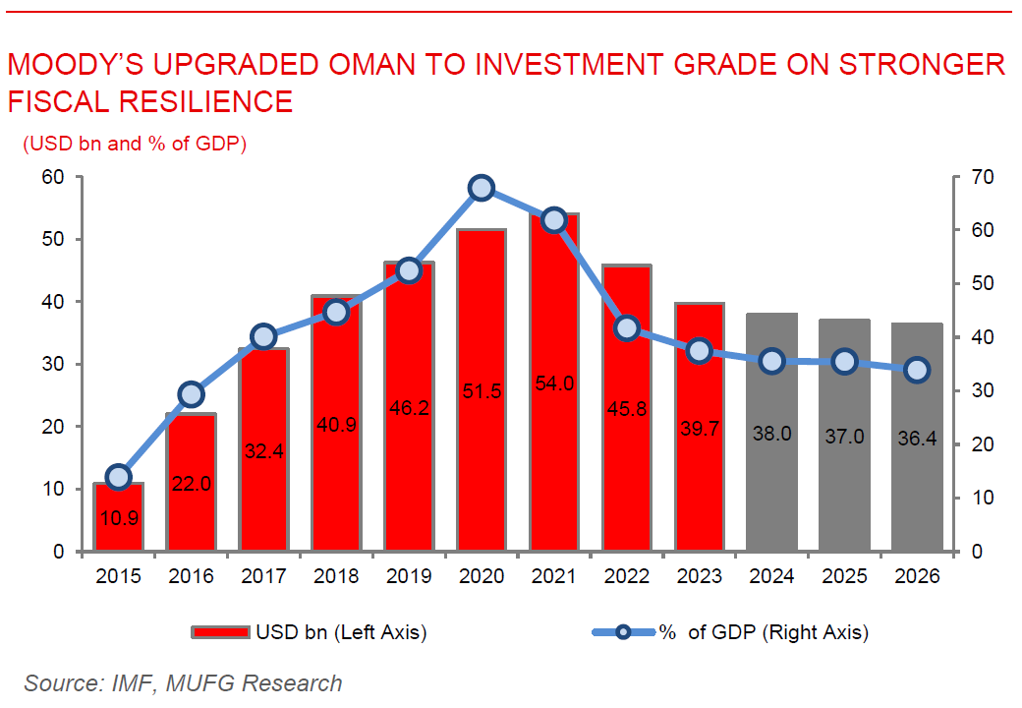To read the full report, please download the PDF above.
Middle East Daily
SOOJIN KIM
Research Analyst
DIFC Branch – Dubai
T: +44(4)387 5031
E: soojin.kim@ae.mufg.jp
MUFG Bank, Ltd. and MUFG Securities plc
A member of MUFG, a global financial group
Middle East Daily
COMMODITIES / ENERGY
Oil holds steady as market weighs tariffs and OPEC+ supply outlook. Oil prices steadied on 11 July after dropping more than 2% a day earlier, as traders digested the growing uncertainty around President Trump’s aggressive trade agenda and the implications of rising OPEC+ output. Brent remained below USD69/b, while WTI hovered near USD67/b. Trump continued to escalate trade tensions, proposing blanket tariffs of up to 20% on most trading partners and hinting at a forthcoming “major statement” on Russia, fuelling concerns about the global economic outlook. These levies, set to take effect on 1 August, come on top of country-specific duties and growing hostilities in the Red Sea, further unsettling the market. Meanwhile, OPEC+ is reportedly considering pausing further production hikes after August, potentially concluding its latest round of output increases a year earlier than originally planned, as concerns mount over a supply glut later this year.
Gold steady as traders weigh tariff risks and Fed outlook. Gold held firm above USD3,332/oz on 11 July, stabilised after a two-day climb as investors assessed the impact of President Trump’s mounting tariff threats and mixed signals from the Fed on interest rate policy. The president’s sweeping proposals this week, including new levies on Canada, Brazil, and copper imports, have stoked market uncertainty ahead of the 1 August implementation deadline, boosting the appeal of safe-haven assets. Although Gold posted a weekly loss, it has surged over 25% in 2025, driven by geopolitical tensions, central bank purchases, and lingering concerns over the global economic fallout from Trump’s evolving trade agenda
MIDDLE EAST - CREDIT TRADING
End of day comment – 10 July 2025. Another day with subdued activity. Flows are still skewed to selling lead by ETF accounts and as result the market closes another 1/5bp wider. The morning saw cash struggling to adjust higher with the UST move overnight and spreads started 5bp wider across names as the market still felt heavy from yesterday selling. However flows became more balanced during the day and with UST weakness spreads started to come in. QATAR was underperforming in IG today, whilst 49s still have a good bid (-0.125pt/+2bp), 48s and 50s traded softer closing -0.5pt/+5bp both. ADGB was much quieter with light two way flows in long end bonds closing broadly unch in cash prices and +1/2bp. Same picture in quasis, QPETRO underperformed with RM selling the curve, 41s closing -0.25pt/+5bp whereas Abu Dhabi names closed unchanged in cash prices, seen some buying in ADQ bonds after the recent widening. 35s closing unch/+1bp. Fins and corps had a quiet day, in corps front end DPWDU got sold but the market took bonds down easily, 29s/30s closing unch/+2bp. Whilst macro markets are still brushing off any trade related headlines, MENA credit saw a bit of pushback of YTD spread tights marked last week. It still feels selling is met by willing buyers and the move wider was very gradual. Whilst awaiting the UST auction, the market feels stronger going out that at any point this week.
MIDDLE EAST - MACRO / MARKETS
Egypt paused rate cuts amid regional risks and tariff uncertainty. Central Bank of Egypt (CBE) held its benchmark interest rate at 24.0% on 10 July, ending two straight rounds of monetary easing as it weighed heightened regional tensions and the inflationary risks tied to President Trump’s new tariff measures. Despite a cooling in inflation to 14.9% in June, policymakers opted for caution, citing the need to assess the impact of recent VAT reforms and global developments before proceeding further with rate cuts. Egypt still maintains one of the world’s highest real interest rates, a key draw for foreign investors. The pause follows the country’s record rate hike and currency devaluation in March 2024, which unlocked USD57bn in external financing. The IMF has since urged a prudent approach to easing, given global volatility and the potential inflation pullovers from US trade actions.
Moody’s upgraded Oman to investment grade on stronger fiscal resilience. Moody’s has upgraded Oman’s credit rating to ‘Baa3’ from ‘Ba1’, returning it to investment-grade status with a stable outlook. The upgrade reflects Oman’s significantly improved fiscal metrics, with government debt falling to 35.5% of GDP in 2024, down from 37.5% in 2023 and over 60% in 2020, alongside reduced spending levels and a fiscal breakeven oil price now below USD70/b. Moody’s expects debt metrics to remain strong even if oil prices fall below USD65/b, supported by gradual non-oil revenue growth and fiscal reforms. While diversification efforts are progressing, risks remain due to Oman’s heavy reliance on hydrocarbons and exposures to global energy transition pressures.

